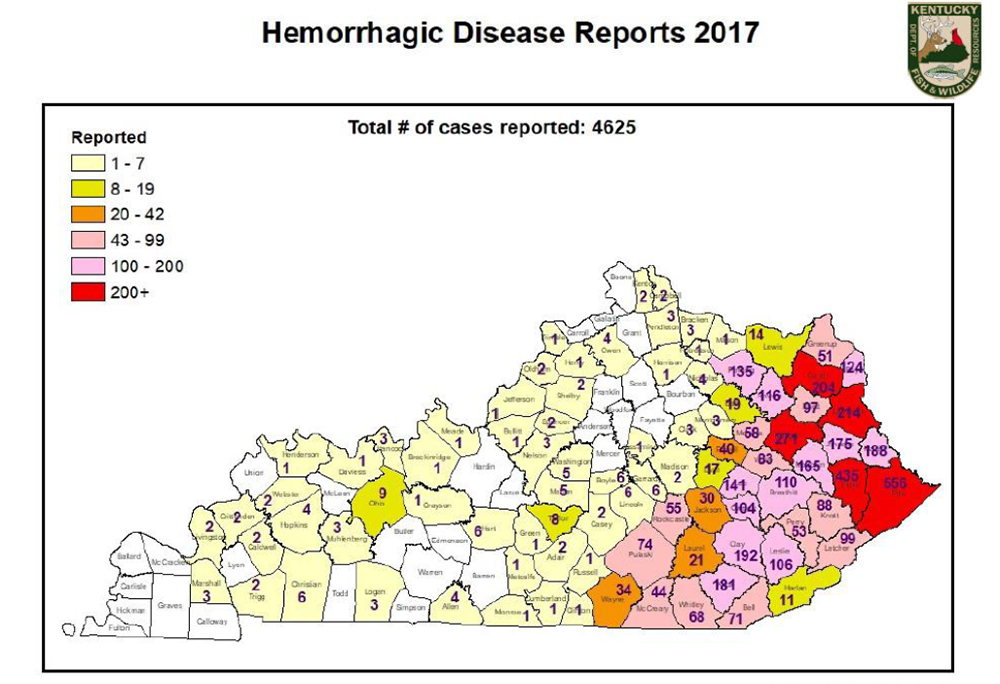
Kentucky’s 2021-22 white-tailed deer season opens with archery hunting on September 4 and state wildlife officials are optimistic.
“I expect another great season here in Kentucky,” said Kyle Sams, deer biologist for the Kentucky Department of Fish and Wildlife Resources (KDFWR). “ Most of Kentucky’s deer numbers are stable to increasing. (Herds) in eastern Kentucky are still recovering from the Hemorrhagic Disease outbreak in 2017. (They are) increasing, though at a slow rate.”
This promising outlook comes on the heels of an excellent 2020-2021 deer season when hunters checked in 141,630 deer, the fifth-highest harvest total on record, surpassing the 10-year average of 137,008. This was despite rainy and windy weather during the November modern gun season, deer season’s main event.

Sams said increased hunter turnout and more participation in outdoor pursuits in general, appears to be a national trend, in response to the constraints of the COVID-19 pandemic.
At the end of last season, KDFWR reported that hunter numbers surged, with more than 320,000 hunting licenses were sold in 2020, a significant jump from the previous year’s total.
But the increase in hunters did not have any effect on the deer hunter success rate. “Over the past 15 years, the deer hunter success rate has changed very little,” said Sams, adding that “77 percent of Kentucky deer hunters are only willing to take one deer per year.”
Kentucky’s deer herd is estimated to number about one million. Herds are healthy, with a favorable growth rate in most counties. “The differences in growth rates (are) greatly affected by habitat type,” said Sams.
For this upcoming season, there are no changes to the zone status of Kentucky’s 120 counties, season lengths or bag limits. There are 51 Zone 1 counties, 34 Zone 2 counties, 13 Zone 3 counties and 22 Zone 4 counties.

The 2021-22 deer season dates are:
• Archery: September 4 through January 17.
• Youth/Senior crossbow: September 4 through January 17.
• Crossbow: September 18 through January 17.
• Youth-only modern gun: October 9-10.
• Early muzzleloader: October 16-17.
• Modern gun: November 13-28.
• Late muzzleloader: December 11-19.
• Free youth weekend: January 1-2.
Impact of EHD on Eastern Kentucky’s Deer Herds
The 22 Zone 4 counties are in southeastern Kentucky, the region of the state hardest hit by the 2017 outbreak of Epizootic Hemorrhagic Disease (EHD), specifically the EHD-2 strain.
The epicenter was in Magoffin, Floyd and Pike counties, and the outbreak spread southwestward. The hardest-hit counties were mostly east of Interstate 75, but eventually, a total of 4,625 reports came in from about 90 Kentucky counties.
“We get EHD outbreaks every year, some are just worse than others, like in 2007, 2012, and 2017,” said Sams.
In Recent White-Tailed Deer Trends in Eastern Kentucky, published in March, 2021, he wrote that “many of these counties are currently seeing a reduction in deer harvest due to a reduction in the deer herd and more conservative harvest regulations put in place as a response to the disease outbreak.”
Deer herds and deer harvest in the region are slowly building back to pre-2017 levels.
Here’s three examples, from the deer harvest numbers posted on the department’s website:
• In Magoffin County, hunters reported taking 422 deer during the 2016 season. The total deer harvest fell to 156 in 2017 but rebounded to 312 during the 2020 season.
• In Floyd County, hunters reported taking 891 deer during the 2016 season. The total deer harvest fell to 196 in 2017 but rebounded to 587 during the 2020 season.
• In Pike County, hunters reported taking 1,508 deer during the 2016 season. The total deer harvest fell to 542 in 2017 but rebounded to 1,206 during the 2020 season.

The infectious viral disease, that kills wild ruminants periodically throughout the eastern half of the U.S. and southern Canada, is spread by several species of flying insects in the genus Culicoides. A 1/10-inch midge, Culicoides sonorensis, is the primary vector in Kentucky.
Deer usually die in eight to 36 hours following the onset of observable signs, which include labored breathing, excessive salivation, no fear of humans, lameness, swelling of the head, neck or eyelids, or blue tissue coloration around their mouth and nose. Some deer that contract EHD can get the chronic form, with symptoms lasting for a couple of weeks.
High fever causes deer to seek out water. That’s why carcasses are usually found in or near farm ponds, lakes or streams. In areas with recurrent outbreaks, some deer develop antibodies that give them immunity from EHD.
Deer Season Regulations
All the details on the 2021-22 Kentucky deer season are available online at fw.ky.gov.




















